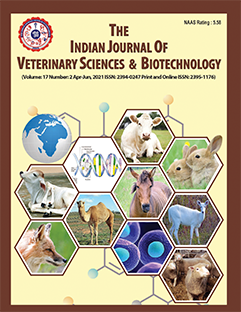Diagnosis and Therapeutic Management of Trypanosoma evansi in an American Bully with Corneal Opacity
DOI:
https://doi.org/10.48165/ijvsbt.21.6.36Keywords:
weakness, various domestic, infection, medicines for dogs, red blood cellsAbstract
Trypanosomosis is a haemoprotozoan infection, caused by different members of Trypanosoma species. It is widely dispersed form of animal trypanosomosis that is harmful, affecting various domestic and wild animal species (Eloy and Lucheis, 2009). Most of the time, the parasite is mechanically transmitted by biting flies like Tabanus, Stomoxes, Tsetse and Culicoides (Green, 2006). Canine trypanosomosis varies in severity from acute to subacute and chronic form. Dogs are frequently affected by an acute and severe form, which may result in death within two to four weeks (Soulsby, 1982). The clinical manifestations of canine trypanosomosis include weight loss, growing weakness, anorexia, anaemia, intermittent fever, conjunctivitis, swelling of the head, throat and limbs, staggering gait, enlarged superficial lymph nodes, difficulty in swallowing and corneal opacity due to strong reactions from the immune system (Kumar et al., 2020). One of the main symptoms of this condition is anaemia, which is caused by the mononuclear phagocytic system expelling red blood cells from the bloodstream. After an infection lasting several months, anaemia may recover to varying degrees when the parasitaemia becomes low and sporadic (Urquhart et al., 2002). The World Animal Health Organization currently classifies T. evansi as a multi-species illness and a zoonotic disease, following the clinical case reports of human trypanosomosis in Egypt and India (Aregawi et al., 2019). A single dose of diminazene aceturate is sufficient to eradicate a trypanosomosis infection in dog (Agrawal et al., 2020); however there are several more efficient trypanosomacidal medicines for dogs, such as suramin and quinapyramine (Rani and Suresh, 2007). Giving diminazene diaceturate to dogs at a dose rate higher than 3.5 mg/kg body weight is deemed lethal (Han et al., 2014). In India, the occurrence of canine trypanosomosis is sporadic in nature (Behera et al., 2017). However, no report on canine trypanosomosis with ophthalmic involvement has been reported in western India in particular Gujarat. Therefore, the present case report documents on the clinical presentations, diagnosis, haemato-biochemistry and therapeutic management of trypanosomosis in an American bully dog from Gujarat.
Downloads
References
Agrawal, H., Jaiswal, M., & Tripathi, A.K. (2020). Successful management of trypanosomiasis in a dog. Indian Journal of Veterinary Medicine, 40(2), 35–36.*
Allam, L., Ogwu, D., Agbede, R.I.S., & Sackey, A.K.B. (2011). Haematological and serum biochemical changes in gilts experimentally infected with Trypanosoma brucei. Veterinarski Arhiv, 81, 597–609.*
Aregawi, W.G., Agga, G.E., Abdi, R.D., & Büscher, P. (2019). Systematic review and meta-analysis on the global distribution, host range, and prevalence of Trypanosoma evansi. Parasites & Vectors, 12, 1–25.*
Behera, S.K., Sarma, K., Behera, P., & Ali, A.M. (2017). Therapeutic management of trypanosomosis with ophthalmic involvement in a dog. Journal of Parasitic Diseases, 41, 1162–1165.*
Coles, E.H. (1986). Veterinary Clinical Pathology (4th edn., pp. 53–56). W.B. Saunders Company, Philadelphia, USA.*
Eloy, L.J., & Lucheis, S.B. (2009). Canine trypanosomiasis: Etiology of infection and implications for public health. Journal of Venomous Animals and Toxins including Tropical Diseases, 15, 589–611.*
Green, C.E. (2006). Infectious Diseases of Dogs and Cats (3rd edn., pp. 676–680). Elsevier, Missouri, USA.*
Gunaseelan, L., Kumar, K.S., Selvaraj, P., & Kathiravan, D. (2009). Haemato-biochemical changes in a case of canine trypanosomiasis. Tamilnadu Journal of Veterinary and Animal Sciences, 5(3), 122–123.*
Han, D., Yoon, W.K., & Hyun, C. (2014). Cerebellar encephalopathy from diminazene aceturate (Berenil) toxicity in a dog. Korean Journal of Veterinary Research, 54(3), 193–196.*
Jeyabal, L. (2019). Per acute case of Trypanosoma evansi in a Dobermann – A case report. Biological Forum, 11(2), 170–173.*
Kumar, H., Sharma, V., Kumar, S., & Mishra, A. (2020). Diagnostic and therapeutic management of canine trypanosomiasis: A case report. The Pharma Innovation Journal, 9(3), 112–113.*
Kumar, B., Brahmbhatt, N.N., Thakre, B., Maharana, B.R., Parmar, V.L., & Kumar, M. (2024). Molecular identification of haemoparasites in animals using blood lysate PCR: A quick and inexpensive alternative to purified whole genomic DNA. Animal Biotechnology, 35(1), 2390935.*
Nwoha, R.I.O., Eze, I.O., & Anene, B.M. (2013). Serum biochemical and liver enzyme changes in dogs with single and conjunct experimental infections of Trypanosoma brucei and Ancylostoma caninum. African Journal of Biotechnology, 12(6), 618–624.*
Orhue, N.E.J., Nwanze, E.A.C., & Akafor, A. (2005). Serum total protein, albumin and globulin levels in Trypanosoma brucei infected rabbits: Effect of orally administered Scoparia dulcis. African Journal of Biotechnology, 4, 1152–1155.*
Rangasamy, V., Annamalai, L., Kanniappan, V.M., Mani, S., Natarajan, B.P., Chinnaswamy, P.P., & Alagarsamy, A. (2024). Occurrence of Trypanosoma evansi infection in Rottweiler dog from Cauvery delta region of Tamil Nadu, India: A case report. Iranian Journal of Parasitology, 19(3), 370–375.*
Rani, N.L., & Suresh, K. (2007). Canine trypanosomiasis. Indian Veterinary Journal, 84, 186–187.*
Reddy, B.S., Kumari, K.N., Sivajothi, S., & Rayulu, V.C. (2016). Haemato-biochemical and thyroxin status in Trypanosoma evansi infected dogs. Journal of Parasitic Diseases, 40, 491–495.*
Soulsby, E.J.L. (1982). Helminths, Arthropods and Protozoa of Domesticated Animals (7th edn., p. 533). Bailliere Tindall, London.*
Thirunavukkarasu, P.S., Rao, V.V., Srinivasan, S.R., Nambi, A.P., & Dhanapalan, P. (2004). Haemato-biochemical findings in case of trypanosomiasis in dog: A clinical study. Indian Journal of Veterinary Medicine, 24, 117.*
Urquhart, G.M., Armour, J., Duncan, J.L., Dunn, A.M., & Jennings, F.W. (2002). Veterinary Parasitology (2nd edn., p. 217). Blackwell Science Co., UK.pp .217
Downloads
Published
Issue
Section
License
Copyright (c) 2025 Indian Journal of Veterinary Sciences and Biotechnology

This work is licensed under a Creative Commons Attribution-NonCommercial-NoDerivatives 4.0 International License.




